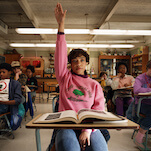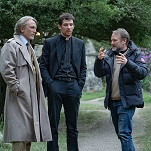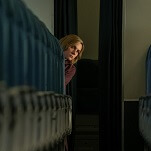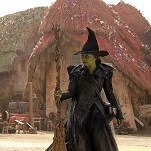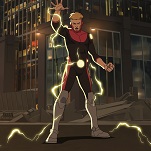When Doll & Em debuted Stateside last year, it was greeted as another showbiz satire. After all, Emily Mortimer plays herself, an actress who takes in her childhood friend, Dolly Wells, played by herself. Susan Sarandon and Chloë Sevigny show up in the second episode. Andy Garcia follows. We hang out on a movie set, there’s a wünderkind first-time director, and everyone’s a bit larger than life. Doll & Em was our new Episodes, which was our new Extras. If that were the whole story, the yawns would be understandable. But that isn’t the half of it.
Emily doesn’t just take Dolly in; she takes Dolly on as her personal assistant. It’s supposed to be a pretext for the pair to spend some quality time together. Emily isn’t seriously going to make her best friend get up at the crack of dawn to get her coffee. “Really, I don’t need coffee… I mean, I can tell you what kind of coffee I like, just in case…” Danger, danger! Now we have old friends sorted by life into a massive power imbalance with blurred lines all over the place. That’s the trunk of the show. Everything arises out of that confused central relationship. It’s a love that’s stood the test of time, but not power.
Doll & Em does turn the movie industry into an expressionistic shadow of itself, but primarily to heighten the tension. Emily’s haunted by the diminishing sex appeal of the middle-aged actress, and she’s dogged by the industry’s narrow conception of interesting, valuable womanhood. “I am not a strong woman!” she eventually screams. “I’m fucking vulnerable!” The counterbalance is a cast of famously independent, socially conscious, feminist actresses Sarandon and Sevigny, followed in season two—which begins Sunday on HBO—by Olivia Wilde and Evan Rachel Wood. Politeness is an oppressive force in Doll & Em’s Hollywood, and the climax of the first season has Emily throwing a Norma Desmond tantrum, turban and all. See, Doll & Em isn’t at its core an Episodes culture clash or an Extras underdog struggle: It’s an All About Eve psychodrama.
If Eve is its mother, its father is The Servant, Joseph Losey’s story of the lines blurring and roles reversing between an Englishman and his man. There’s tension between the characters, tension between what you’re sure you’re seeing and what you think you’re seeing, tension between the way things are supposed to be and the way they’re turning out, all stirred up by what passes in the fraught silences between the characters. That darkness is what distinguishes Doll & Em among the recent wave of real-life BFF comedies. Best Friends Forever, Playing House, and Broad City showcase unconditionally loving, almost dangerously supportive female friendships. Doll and Em’s relationship is less pure. They want to help each other, but they’re selfish and insecure and thoughtless. They’re more like Steven Coogan and Rob Brydon in The Trip, passive-aggressive until it’s time to be just plain aggressive. When Emily has to go to some soiree, Dolly decides to take a dip in the pool, but somehow she gets locked out. Half a day later, Emily comes home completely hammered, complaining about how terrible the food and the company were. Freezing and starving, Dolly just slumps off to bed in her bikini waiting for Emily to notice she’s upset, but Emily’s too blinkered, and not just by alcohol. Dolly sniffles, “I just want to go home.” Emily says, “Don’t say that. You’re gonna make me feel horrible.”
What sets Doll & Em apart most immediately, though, is its look. The colors are restrained, the lights are low, and the camera’s a nervous wreck. It’s not enough to say Doll & Em has a handheld style. Everything has a handheld style. What’s going on here is so mobile it’s practically a home video. That’s just one element of the show’s DIY feel. The cast is composed of Mortimer’s old co-stars like Jonathan Cake (Parlour Song) and Ewan McGregor (Young Adam), as if everybody’s pitching in. What became Doll & Em was originally shot on a DSLR by the best friends and Mortimer’s husband, Alessandro Nivola, who produces and joins the cast in season two. But most responsible for the handmade look is the third leg of the triangle, Azazel Jacobs, who writes (with Mortimer and Wells) and directs every episode.
Jacobs is the microbudget auteur behind Momma’s Man, the editor and cinematographer of which reprise their roles on Doll & Em (Darrin Navarro and Tobias Datum, respectively). The story follows an adult who finds himself regressing on a visit to his parents’ loft that turns into an extended stay. The production resembles Doll & Em, in that the parents are played by Jacobs’ actual parents, avant-garde filmmaker Ken and Flo Jacobs, and the setting is their actual apartment. The loft Azazel Jacobs grew up in is an antique store jungle, festooned with knickknacks like film canisters and wind-up toys. Perhaps that contributes to Jacobs’ sharp sense of texture and collage. His earlier film, The GoodTimesKid, a dirty, deadpan doppelgänger story, makes pointed use of layered backgrounds, like a refrigerator dotted with photos and magnets or a houseboat full of maps and books and octopus décor. Jacobs’ movies look like mixed media, like the actors are part of a giant arrangement of objects of various shapes and sizes, patterns and textures.
Accordingly, Emily and Dolly become the subjects of a rich three-dimensional image, every object with a history that brought it to this point, the whole living sculpture arranged for the cumulative effect. Television just doesn’t look like that. Even the most expressive shows fall short: Please Like Me is too tidy, Hannibal too narrow, Mad Men too careful. Doll & Em is a scrapbook of decoration and layers. One memorable moment finds Dolly deep in the reflection of a vanity mirror, framed by those cutesy bulbs, glimpsed through an array of paper cards and dangling gold ribbons. It’s like a page from an I Spy book. Doll & Em deserves a dozen Emmys just for bringing deep focus back to TV.
There’s method to the madness. Jacobs’ disorganized layering and often soft, almost dainty textures serve the same three ends as his jittery camerawork. First, they drain Hollywood of its glamour. There’s none of The Comeback’s candy colors or Episodes’ polished sheen. Doll & Em is pure grunge. Second, they heighten the psychodrama. Watching Dolly squeeze herself between the vine-covered fence and the stucco walls trying to find an unlocked door into her new home via the nervy, nervous view of the camera is tense. The home-video quality casts us as a silent observer trained on Dolly and particularly Emily throughout their power struggle, and the disorder of the compositions contributes to the chaos. Finally, they bring out the delicacy at the heart of this story. At the end of the day, Dolly and Emily are childhood friends who think the world of each other, and the feeling that we’re watching a video scrapbook of their lives is a testament to that.
To their credit, Mortimer, Wells, and Jacobs don’t swim in place. Season two, beginning Sunday at 10:30, follows a new stage in Dolly and Emily’s lives, this time in New York. Swapping psychological warfare for physical deterioration, it’s a calmer season, with a wider array of women’s voices and more emphasis on some of the other underpinnings of the show, like the creative process and being English in America. But you can catch up on that magnificent music box of a first season now on HBO Go or On Demand. It might sound like something you’ve seen before, but Doll & Em is one of a kind.

